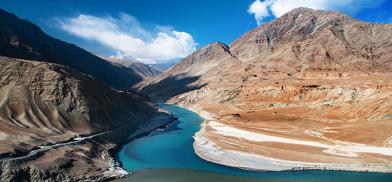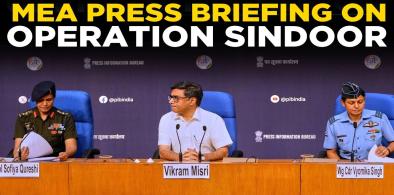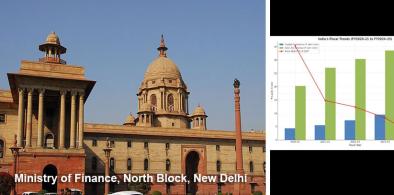Pakistan's once-mighty Indus, a lifeline for millions, is dying slowly
Hence, in the span of only one and a half-century, a mighty river like the Indus has been imprisoned in dams, bridges, and barrages, which has severely disturbed the river’s flow, writes Muhammad Abbas Khaskheli for South Asia Monitor

Centuries ago, the mighty Indus river, famously known as Sindhu, used to end up at the Arabian Sea like the wildest horse running aggressively towards its destination. But it is not the same now. Today, if the King River (known as Darya Badshah) of bygone days would be seen via a satellite image it would bear the resemblance to a small and narrow water tributary - appearing, disappearing and reappearing simultaneously.
The fate of this mighty and historical river was doomed when the Britishers first made obstructions to block its stream in order to introduce an irrigation system in Sindh. Right from its origin in the Tibetan Plateau to meeting the Arabian Sea, its flow has been the fastest in Sindh rather than its upper riparian (Punjab).
The first obstructions
In earlier times, for the purpose of reaching from one bank to another people used to travel by boats, and at some points where the riverbed was narrow, they also made bridges of boats. The citation of one of such bridges is also mentioned in historical ‘The battle of Khar’rri’ that fought in Sukkur in 1834 between the armies of Afghani invader Shah Shujah Durrani and Talpurs of Sindh. There was also a similar type of famous bridge somewhere around Attock in those days.
In the times of British rule, the river was forced to flow in one/straight direction from Guddu to the district Thatta (covering around 600 km) by blocking it from both left and right banks. It was the first manmade death/obstruction given to the mighty river’s natural flow.
When the British occupied Sindh, Punjab, and NWFP (Khyber Pakhtunkhwa nowadays) provinces, they introduced irrigation and railway systems to fulfill their economical and militaristic endeavors. In 1883, a bridge named Attock Bridge was constructed near Attock in Punjab province for railway purposes. For a similar purpose in 1889, the Lansdowne Bridge was constructed between Sukkur and Rohri. Many years later in 1932, Lloyd Bridge was constructed in Sukkur over the Indus River which is also famously known as Sukkur Barrage. It was made to meet irrigation purposes.
Slow death of a river
Since the inception of Pakistan, Tarbela Dam, and five more barrages -Jinnah Barrage, Chashma Barrage, Taunsa Barrage, Guddu Barrage, and Kotri Barrage - have been made over the Indus river – which is Pakistan's primary freshwater source on which its agriculture and industry depends and also hydropower generation - while the work on Diamer-Basha Dam is underway. Every time, they construct a new bridge, the Pakistani government seems to be giving the same old justification but packaged in a new way – “it’s for electricity/power generation and water storing purposes.”
After these dams and barrages, the government has been frequently been planning to make bridges over the Indus river in Sindh to lessen travel time for people.
In connection to such planning, firstly Dadu-Moro Bridge was constructed in 1982 which was followed by two more bridges Sukkur Bypass Bridge and Khairpur-Larkana Bridge. In the meantime, two more bridges namely the Thatta-Sujawal bridge and Jhirk-Mula Katiar bridge were also constructed in two coastal belt districts of Sindh. After that Kazi Ahmed-Manjhand Bridge and Hyderabad-Jamshoro Bridge was constructed over the Indus river.
In this way, around 10 long and short bridges have been made over the Indus river so far in Sindh alone while the work on another bridge connecting Ghotki and Kandhkot districts is in progress. The government also plans to make another bridge between Rohri and Sukkur cities over the Indus river in near future with the intention to cope with overgrowing traffic jam problems in both cities. Pakistan’s Water and Power Development Authority (WAPDA) is already working on Sindh Barrage which is a government-approved project to be completed by December 2024. Hence, in the span of only one and a half-century, a mighty river like the Indus River has been imprisoned in dams, bridges, and barrages, which has severely disturbed the river’s flow.
Undoubtedly, water shortage in the Indus basin system can be considered one of the major causes behind the river’s flow but that too happened since the dams and barrages were made upstream. On the other hand, the construction of bridges over the Indus River has put some serious effects on the river’s natural flow. In this regard, if one takes Khairpur-Larkana Bridge or Dadu-Moro Bridge in an account, the river bed under these two bridges has shrunk significantly as at present it’s not more than a one-and-a-half kilometer long which once used to be stretched over more than three kilometers. Similarly, the bridges in Jamshoro, Sujawal and Thatta districts have a similar type of design-related faults and technical flaws. These reasons contributed to creating hindrance to the free-flowing river water.
This has resulted in further problems. The submerging area of the river (Kacho in Sindhi) is increasing rapidly and people are fast occupying those vacant lands for both residential and commercial purposes. The shrinkage in the flow of water has caused a shortage of water all over Sindh, hence the underground freshwater is also disappearing from the surrounding areas from where the river passes. The distribution of water for irrigation purposes is considerably disturbed consequently, lands are becoming barren.
In times of floods, pressure on barrages increases and there always remains a risk of crumbling of the riverbank blocks. Deforestation has increased drastically and there is a severe threat to some aquatic species, including Pallo (Hilsa fish) and the already threatened Blind Dolphin which is now only restricted to river areas between Sukkur and Guddu Barrages.
The world’s fifth-largest delta system, Indus Delta, is also fast becoming a no man’s land with the world’s seventh-largest mangrove forest disappearing due to the unavailability of the required amount of water. Many lakes have been dying including the famous Manchar Lake, the largest natural freshwater lake.
Don't block the flow
All these bridges and barrages on the Indus clearly indicate that there are blockages in the flow of the river water. A similar threat has already been observed during the deadly 2010 floods which demolished almost half of the province. So, one thing is very clear that bridges on the river should be constructed in such a way that the natural flow of the river would not be disturbed.
There are several examples in the world where bridges (Like Sydney Harbor Bridge) over the rivers are made from one bank to another not by constructing pillars or structures within the river bed. There are no roads on either side of the banks within the river bed like we have in Sindh. Sadly, all upcoming bridge and barrage construction projects in Sindh have similar old strategies and designs.
We have to understand that bridges’ location and alignment also matter. For the purported facilitation of people, we should not bind the Indus river in chains of dams, barrages, and bridges because it’s a lifeline, and one of the major sources of living for the next generation.
(The writer is a Pakistan-based columnist on environmental and social issues. The views are personal. He can be reached at abbaskhaskheli110@gmail.com)
south asia news
you make blogging look easy. The overall look of
your web site iss fantastic, let alone the
content!
I'm happy that yoou shared this useful info with us.
Please keep us up to date like this. Thanks for sharing.
my myspace group? There's a lot of folks that Ithink wkuld really enjoy your content.
Please llet me know. Many thanks
I have bookmarked iit for later!
And after this article Pakistan's once-mighty Indus, a lifeline for millions, is dying slowly | South Asia Monitor.
I was excited enougvh to leave a thought :-P I actually do have a couple of questions
for you if it's okay. Is it simply me or doo a feww of thee responses look like they are left by brain dead visitors?
:-P And, if you aree writing on other online social sites, I
would like to keep up wit you. Would you mzke a list every one of your public sites like your Facebook page, twittdr feed,or linkedin profile?
page conations really pleasant funny stuff too.
Will there be a part 2?
well written article. I'll be sure to bookark it and
return to read more of your useful information. Thanks for the post.
I will definitely comeback.
And i'm glad studying your article. However want to commentary on few common things, Thee site taste is ideal,
the articles is realkly nice : D. Good process,
cheers
of writing iss truly fruitful in support off me, keep up posting
these posts.




















Post a Comment